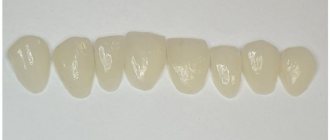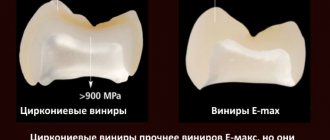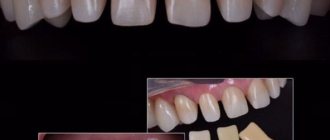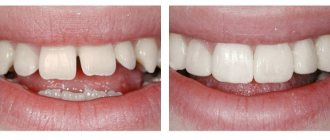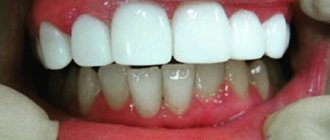Once upon a time, our ancestors made dishes from ceramics, but today they can be used to make the thinnest plates that can turn a smile into a real work of art. We are talking about installing ceramic veneers, with the help of which it is possible to give teeth an ideal shape and aesthetic shade, while preserving their natural transparent structure. Magomed Umatgireevich Dakhkilgov, chief physician of the GERMAN IMPLANTOLOGY CENTER, told us about all the nuances of the unique procedure.
What are porcelain veneers?
A ceramic veneer is a thin plate of high-quality ceramics approximately 0.3 - 0.5 millimeters thick. The microprosthesis is fixed to the external tooth surface using special cement. Veneers correct the color, shape and slight curvature of teeth, trema and diastema, as well as crowding.
Photos before and after installation of ceramic veneers at the Research Center. Works by Avetisyan R.A., Dakhkilgov M.U., and Karneev A.N.
Other methods of installation on teeth
If the tooth surface is not ideal, more thorough preliminary grinding of the enamel will be required. Usually a layer about 0.5-0.7 mm thick is removed. To ensure that the patient does not feel discomfort for 1-2 weeks while the permanent plates are being made, temporary therapeutic veneers are installed. The technology for installing them is quite simple:
- The treated tooth surface is coated with an adhesive substance to improve adhesion to the plate.
- The composite material is applied, distributed evenly, and then exposed to a stream of light, which promotes rapid hardening.
- The veneer will be completely formed after applying 2-3 such layers.
- Finally, it is ground to a perfectly smooth shape and polished to achieve maximum aesthetic results.
This method of restoration is called “direct” veneering . The procedure takes no more than an hour.
Advantages of ceramic veneers over composite ones
Unlike composite ones, the advantages of ceramic onlays are obvious to any specialist. And here's why: even the most expensive composite is actually plastic; it quickly loses its shine, darkens and delaminates over time. This means that composite veneers are less durable and aesthetically pleasing. Ceramic veneers, on the contrary, cannot be stained, do not change their shape, retain their relief and have the shine of natural teeth. All this makes restorations an excellent tool for creating an ideal smile, without which modern aesthetic dentistry is unthinkable. The only disadvantages of ceramic veneers are the price and complexity of installation, which require the patient to carefully approach the choice of a dental clinic.
Composite veneers: price 2020
The price for composite veneers in Moscow and St. Petersburg in mid-price clinics in 2020 will be about 8,000 – 9,000 rubles (per 1 unit). The minimum price in Moscow in economy class clinics will be from 4,500 rubles, and the maximum price will be about 15,000 rubles.
As we said above, making a composite veneer requires artistic talent, and very few dentists have the skills to artistically restore anterior teeth. Typically, talented doctors always participate in various regional dental competitions, during which they have to treat real patients and the jury gives marks for this... And the more certificates a doctor has of all kinds, especially if he was a winner or prize-winner in the “artistic restoration” category, the more There will be a greater chance of getting really good composite veneers.
How is a ceramic veneer different from a lumineer?
By and large, Lumineers are the same ceramic veneers, but more matte, less able to convey the transparency and shine of the enamel, which, in my opinion, leads to a less aesthetic result. The statement that there is no need to prepare before placing lumineers on the teeth is also incorrect. Therefore, I personally do not see the point in lumineing, the quality of which does not suit me, and I prefer to work with classic ceramic veneers.
Indications for use –
Because veneers made from a composite filling material are inferior in strength and other characteristics to ceramic veneers - it is very important to use them only in the right situations. Specifically, they are only suitable for minor changes in the position, shape or color of the front teeth.
- for small chips of enamel,
- to change the color of the tooth crown,
- to eliminate small gaps between teeth,
- if it is necessary to increase the height of teeth (due to their physiological wear).
Important: Most experts do NOT recommend the use of composite veneers if you have wide interdental spaces or too much chipping of the crown of your front tooth, or if the tooth is very crooked or too dark in color. In all these cases, the manufacture of ceramic veneers or ceramic crowns is indicated.
Types of restorations with ceramic veneers
There are two types of porcelain veneers: pressed porcelain and porcelain-fabricated porcelain veneers. Initially, there are no special differences between the two types. The quality of structures is determined by further processing and installation.
Made from pressed ceramic
To create pressed porcelain veneers, wax modeling is first used. A model is created from special wax, according to which a ceramic plate is pressed under high pressure. On the front side of the plate, any anatomical features of the patient’s enamel are recreated. This method is good for accurately conveying the internal surface of the structure adjacent to the tooth.
Manufacturing on a refractor
When making a ceramic veneer using a refractor, special stumps are first created from a refractory mass, and then the ceramic mass is applied to them in layers. The finished structure is subsequently baked in a special oven.
Both types of ceramic veneers are offered. Regardless of the manufacturing method, ceramic onlays are always strictly individualized for the patient and installed at the highest level.
Composite veneers: reviews
When choosing composite veneers, you must understand that the optical properties of composite filling material are far from ceramics, the structure and optical properties of which are as close as possible to natural tooth enamel. Below we have summarized the main advantages and disadvantages of composite veneers...
What are the advantages of composite veneers?
- can be done in 1 visit,
- acceptable aesthetics,
- low cost,
- usually require less grinding of tooth tissue,
- they can be easily removed and replaced without great expense with new ones.
What are the disadvantages of composite veneers?
- not as durable as ceramic ones,
- not as aesthetically pleasing as ceramic ones,
- require regular polishing (every 3-4 months),
- there are often chips,
- absorb dyes and change color,
- there will be abrasion along the cutting edge of the incisors,
- You are unlikely to be able to find a really good dental therapist who could restore the front teeth with veneers so that they look like real teeth and also do not stand out from the background of neighboring teeth.
The usual “quality” of composite veneers will be approximately the same as in the before and after photos below (let’s say right away that patients who have high demands on aesthetics will most likely only be disappointed with such veneers) -
Important: if you look closely at photo 7, you will see that after the installation of composite veneers, the upper front teeth lost the natural translucency of the enamel, becoming completely opaque, and also acquired an unnatural milky tint (not characteristic of natural tooth enamel). We want to say that when choosing composite veneers, unfortunately, you should at best be guided by approximately the same result.
Life time -
Ideally, I would really like to say that a composite veneer will serve you for 5-6 years, but adjusted for the low quality of dental services in Russia, you should aim for 3-4 years. At the same time, it will delight you with good aesthetics for an even shorter period of time, which is due to the characteristics of composite filling materials (they gradually lose their shine, absorb dyes and because of this change their color).
Due to the latter circumstance, if you smoke, like wine, drink strong tea/coffee, like spices such as curry and other coloring foods and drinks, you will definitely not like composite veneers. In this situation, it is better to make veneers from ceramics (they do not absorb dyes and do not change their color). Composite veneers will also require careful care - it is recommended to visit your dentist every 3-4 months for professional polishing to maintain their shine and color.
Composite veneers: photo after 5 years –
Important: dentist reviews for composite veneers are most often good only among those doctors who do them themselves, i.e. among dental therapists. Doctors don’t like to miss out on patients, so it’s rare that a dental therapist will recommend you a real ceramic veneer or an indirect composite veneer (made in a dental laboratory) - because this will mean that the orthopedist and dental technician will receive the money for the work.
Therefore, very often, dental therapists, even if they see that a tooth needs to be restored not with a filling, but with a crown or ceramic veneers, will still recommend that everyone restore the tooth with a filling material. Exactly the same situation arises with the restoration of severely damaged teeth, where instead of a stump inlay and a crown, you will be recommended a pin and a filling.
Contraindications for ceramic veneers
Ceramic veneers can be placed on teeth from the moment when the permanent bite is fully formed, that is, for patients over 18 years of age. However, the decision to undergo veneering should always be balanced and deliberate. The general list of contraindications is as follows:
- Large fillings on front teeth
- Extensive carious lesions
- Gingivitis
- Periodontitis
- Malocclusions
What are there
- Therapeutic ones are created directly on the patient’s tooth from a composite material. Its composition is similar to that of a filling. The dentist gradually restores and restores the tooth in case of severe chips. It is almost impossible to choose the color of the material tone-on-tone due to the limited color range. Composite veneers become stained over time from contact with food coloring. They belong to the budget category and cost from 2,500 to 15,000 rubles.
- Orthopedic ones are made in the laboratory. They require an impression of the patient's teeth. They look indistinguishable from real teeth due to the ability of the materials to transmit light. There are a number of contraindications for their installation: bruxism, bulky fillings, diseases of the dental tissues and gums. Veneers require careful handling. Depending on the model, their price is higher than that of therapeutic pads.
Installation of ceramic veneers
Ceramic veneers are not “seated” onto the tooth using cement, like a filling. Fixing a thin ceramic plate is a complex process. Here it is necessary to follow a clear sequence of actions: first you need to etch the veneer, then wash it with a special solution, then apply a special substance to it, etc. Only by following a clear procedure can you ensure a high-tech installation of a ceramic veneer, in which adhesion between it and the tooth happens at the chemical level. The structure should not just stick to the tooth surface, but practically fuse with it. As for the sequence of actions in a broader sense, it all starts with consultation.
- Consultation
. First of all, it becomes clear what the nature of the problem that a person wants to solve with the help of veneering is. Here, first of all, attention is paid to the bite. If the defect is in the frontal region and is associated with orthodontics, orthodontic treatment with braces or mouthguards to straighten the teeth is first suggested.
- Fitting
. Next, an impression is made, from which diagnostic models are made. Then, using a silicone key (mock-up technology), the desired changes are transferred to the oral cavity. A special composite is inserted into the key and the expected result of future veneering is “squeezed” onto the teeth. Thus, the patient “tryes on” ceramic veneers on his teeth in advance. This model is quite conventional; a real ceramic veneer looks much better, but a person gets a general idea: he sees exactly how the shape of teeth and even their color can be changed.
- Dental treatment.
When the future parameters of the veneers are approved, using special marking burs, the teeth are prepared directly through the composite of the temporary structures. Excessive grinding of natural teeth is avoided; the doctor acts exclusively within the enamel, and in some places even it is not affected.
- Casts
. After preparation, impressions are taken. Temporary structures are then placed on the teeth.
- Creation and installation.
The production of ceramic veneers ranges from a week to three. The finished onlays are tried on and, if the patient has no complaints, they are fixed on the teeth.
Veneer installation technology
In order for this thin veneer to adhere firmly to the tooth, the enamel surface must be specially treated. This is the most unpleasant thing when installing them. The dentist’s task is to carefully remove the enamel layer. It is only 1.5 mm. After this procedure, the enamel loses its smoothness and becomes rough. On such a surface the lining holds better. The installation process will take about half an hour.
Although it does not cause much pain, an anesthetic stake is often given. When a veneer is installed on the treated surface, all unpleasant sensations will go away. Don't be afraid that they will come back.
Before and after installation of 4 veneers on the upper teeth at the Research Center
Make an appointment
right now!
Dakhkilgov Magomed Umatgireevich
Surgeon, Implantologist
Ceramic veneers without turning
Some doctors are disingenuous when they say that the installation of composite veneers, unlike ceramic ones, requires virtually no preparation. In fact, it is impossible to install composite or ceramic veneers without grinding. However, the higher the quality of the specialist’s work, the less impact there is on the teeth. The teeth are processed only with the help of high-quality German burs, precisely centered and having a strictly specified grain size. Moreover, the installation of ceramic veneers is carried out using a high-tech dental microscope. Thus, through the use of modern technologies and materials, we are able to achieve minimal, but very high-quality tooth processing, literally within the enamel. Thanks to this innovative approach, the plate fits perfectly to the prepared surface, which significantly increases the service life of ceramic veneers.
All the pros and cons of dental veneering
The advantages of the method include:
- speed of the procedure;
- high aesthetic properties;
- long service life of the plates;
- the ability to correct both one tooth and the entire row;
- color stability over a long period of time;
- minimal grinding of teeth;
- allows you to hide almost any defects.
Veneers prevent the development of caries and protect teeth from negative external factors.
Among the disadvantages are:
- In most cases, it is necessary to grind the surface of the teeth under the plate, which can lead to increased sensitivity and pain.
- The procedure is irreversible. It is impossible to remove the plates, but even if this is done, the damaged enamel underneath becomes unattractive. Therefore, having installed veneers once, they will have to be constantly changed in the future.
- Low strength. Cracks and chips may appear on microprostheses due to strong mechanical stress. The patient will have to be very careful, avoid solid foods and visit the dentist regularly.
- Products require increased care - oral hygiene rules must be observed more carefully than usual.

